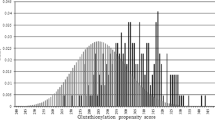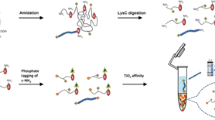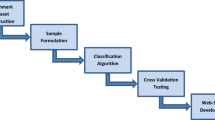Abstract
Protein prenylation is the addition of hydrophobic molecules to a protein or chemical compound. It is a post-translational modification that plays very important roles for many cellular processes such as DNA replication, signaling, trafficking, and other cellular functions in eukaryotes. Protein S-farnesyl cysteine prenylation is a specific kind of prenylation involved in the transfer of a farnesyl moiety to a cytoplasmic cysteine at or near the C-terminus of the target protein. Recent advancements in proteomic technology have stimulated an increasing interested in the identification of protein S-farnesyl cysteine prenylation sites. However, there is still a lack of methods proposed for the prediction of S-farnesyl cysteine sites. With a rapidly increasing number of experimentally verified S-farnesyl cysteine sites, it is motivated in proposed new method for identifying S-farnesyl cysteine prenylation sites.
Access this chapter
Tax calculation will be finalised at checkout
Purchases are for personal use only
Similar content being viewed by others
References
Kamiya, Y., et al.: Structure of rhodotorucine A, a novel lipopeptide, inducing mating tube formation in Rhodosporidium toruloides. Biochem. Biophys. Res. Commun. 83(3), 1077–1083 (1978)
Farnsworth, C.C., et al.: Human lamin B contains a farnesylated cysteine residue. J. Biol. Chem. 264(34), 20422–20429 (1989)
Wolda, S.L., Glomset, J.A.: Evidence for modification of lamin B by a product of mevalonic acid. J. Biol. Chem. 263(13), 5997–6000 (1988)
Soni, R., et al.: Structure-based binding between protein farnesyl transferase and PRL-PTP of malaria parasite: an interaction study of prenylation process in Plasmodium. J. Biomol. Struct. Dyn., 1–12 (2016)
Novelli, G., D’Apice, M.R.: Protein farnesylation and disease. J. Inherit. Metab. Dis. 35(5), 917–926 (2012)
Maurer-Stroh, S., et al.: Towards complete sets of farnesylated and geranylgeranylated proteins. PLoS Comput. Biol. 3(4), e66 (2007)
Palsuledesai, C.C., Distefano, M.D.: Protein prenylation: enzymes, therapeutics, and biotechnology applications. ACS Chem. Biol. 10(1), 51–62 (2015)
Hechinger, A.K., et al.: Inhibition of protein geranylgeranylation and farnesylation protects against graft-versus-host disease via effects on CD4 effector T cells. Haematologica 98(1), 31–40 (2013)
Charron, G., et al.: Prenylome profiling reveals S-farnesylation is crucial for membrane targeting and antiviral activity of ZAP long-isoform. Proc. Natl. Acad. Sci. USA 110(27), 11085–11090 (2013)
Geryk-Hall, M., Yang, Y., Hughes, D.P.: Driven to death: inhibition of farnesylation increases Ras activity and promotes growth arrest and cell death [corrected]. Mol. Cancer Ther. 9(5), 1111–1119 (2010)
Goodsell, D.S.: The molecular perspective: protein farnesyltransferase. Oncologist 8(6), 597–598 (2003)
Einav, S., Glenn, J.S.: Prenylation inhibitors: a novel class of antiviral agents. J. Antimicrob. Chemother. 52(6), 883–886 (2003)
Xie, Y., et al.: GPS-Lipid: a robust tool for the prediction of multiple lipid modification sites, Scientific reports, 6, 28249 (2016)
Maurer-Stroh, S., Eisenhaber, F.: Refinement and prediction of protein prenylation motifs. Genome Biol. 6(6), R55 (2005)
Chen, W.N., et al.: Particle swarm optimization with an aging leader and challengers. IEEE Trans. Evol. Comput. 17(2), 241–258 (2013)
Nguyen, V.N., et al.: A new scheme to characterize and identify protein ubiquitination sites. In: IEEE/ACM transactions on computational biology and bioinformatics IEEE, ACM (2016)
Nguyen, V.N., et al.: Characterization and identification of ubiquitin conjugation sites with E3 ligase recognition specificities. BMC Bioinform. 16(Suppl. 1), S1 (2015)
Lee, T.Y., et al.: Exploiting maximal dependence decomposition to identify conserved motifs from a group of aligned signal sequences. Bioinformatics 27(13), 1780–1787 (2011)
Lee, T.Y., et al.: SNOSite: exploiting maximal dependence decomposition to identify cysteine S-nitrosylation with substrate site specificity. PLoS One 6(7), e21849 (2011)
Boeckmann, B., et al.: The SWISS-PROT protein knowledgebase and its supplement TrEMBL in 2003. Nucleic Acids Res. 31(1), 365–370 (2003)
Lu, C.T., et al.: DbPTM 3.0: an informative resource for investigating substrate site specificity and functional association of protein post-translational modifications. Nucleic Acids Res. 41(Database issue), D295–D305 (2013)
Keshava Prasad, T.S., et al.: Human protein reference database–2009 update. Nucleic Acids Res. 37(Database issue), D767–D772 (2009)
Huang, Y., et al.: CD-HIT suite: a web server for clustering and comparing biological sequences. Bioinformatics 26(5), 680–682 (2010)
Altschul, S.F., et al.: Gapped BLAST and PSI-BLAST: a new generation of protein database search programs. Nucleic Acids Res. 25(17), 3389–3402 (1997)
Chang, C.-C., Lin, C.-J.: LIBSVM: a library for support vector machines. ACM Trans. Intell. Syst. Technol. 2 (2011)
Nguyen, V.N., et al.: UbiNet: an online resource for exploring the functional associations and regulatory networks of protein ubiquitylation. Database : J. Biol. Databases and Curation (2016)
Matthews, B.W.: Comparison of the predicted and observed secondary structure of T4 phage lysozyme. Biochim. Biophys. Acta 405(2), 442–451 (1975)
Burge, C., Karlin, S.: Prediction of complete gene structures in human genomic DNA. J. Mol. Biol. 268(1), 78–94 (1997)
Crooks, G.E., et al.: WebLogo: a sequence logo generator. Genome Res. 14(6), 1188–1190 (2004)
Vacic, V., Iakoucheva, L.M., Radivojac, P.: Two sample logo: a graphical representation of the differences between two sets of sequence alignments. Bioinformatics 22(12), 1536–1537 (2006)
Tung, C.W., Ho, S.Y.: Computational identification of ubiquitylation sites from protein sequences. BMC Bioinform. 9, 310 (2008)
Author information
Authors and Affiliations
Corresponding authors
Editor information
Editors and Affiliations
Rights and permissions
Copyright information
© 2017 Springer International Publishing AG
About this paper
Cite this paper
Nguyen, VN., Tran, TX., Nguyen, HM., Nguyen, HT., Lee, TY. (2017). A New Schema to Identify S-farnesyl Cysteine Prenylation Sites with Substrate Motifs. In: Akagi, M., Nguyen, TT., Vu, DT., Phung, TN., Huynh, VN. (eds) Advances in Information and Communication Technology. ICTA 2016. Advances in Intelligent Systems and Computing, vol 538. Springer, Cham. https://doi.org/10.1007/978-3-319-49073-1_10
Download citation
DOI: https://doi.org/10.1007/978-3-319-49073-1_10
Published:
Publisher Name: Springer, Cham
Print ISBN: 978-3-319-49072-4
Online ISBN: 978-3-319-49073-1
eBook Packages: EngineeringEngineering (R0)




